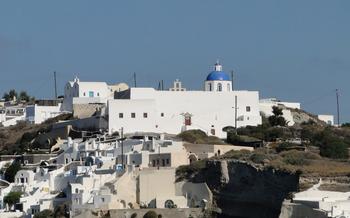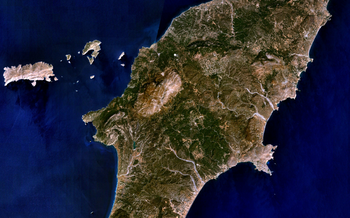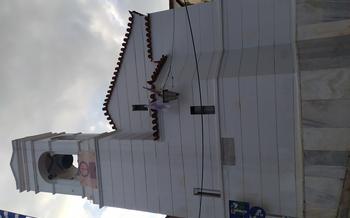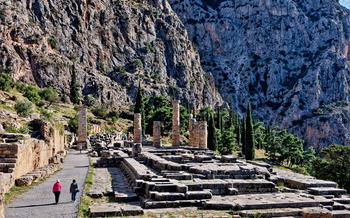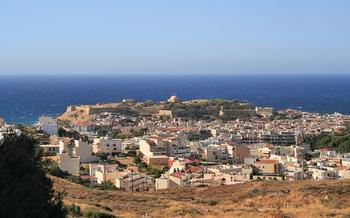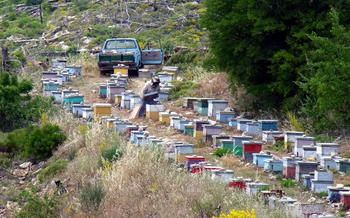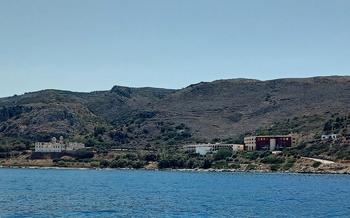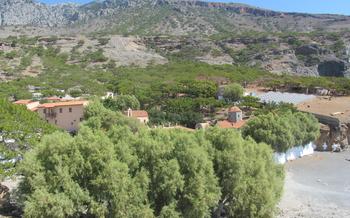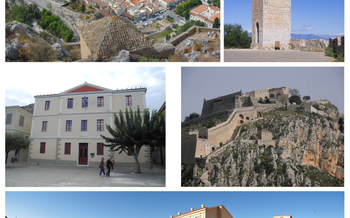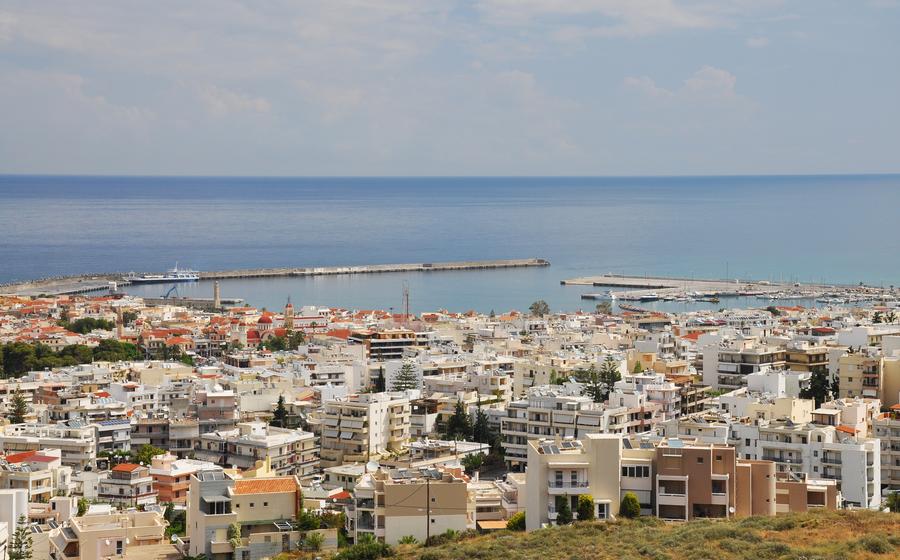
Monastery of Prophet Elias
- The Monastery of Prophet Elias: An Overview
- Location and Accessibility
- Historical Significance of the Monastery of Prophet Elias
- Architectural Features of the Monastery of Prophet Elias
- Religious Importance
- Cultural Significance of the Monastery of Prophet Elias
- Stunning Views and Landscapes:
- Interior of the Monastery
- Museum and Artifacts
- Guided Tours and Information
- Accommodation and Facilities
- Festivals and Events
- Local Cuisine and Hospitality
- Insider Tip: Serenity and Respect
The Monastery of Prophet Elias: An Overview
Perched atop Mount Vrissinas, overlooking the picturesque town of Rethymno, stands the Monastery of Prophet Elias, a sacred sanctuary steeped in history and religious significance. Founded in the 13th century during the Venetian rule, the monastery is dedicated to Prophet Elias, a revered figure in the Greek Orthodox tradition associated with divine power and protection.
Nestled amidst a stunning landscape, the monastery offers breathtaking panoramic views of the surrounding countryside, the shimmering Mediterranean Sea, and the majestic Cretan mountains. Its strategic location has made it a prominent landmark and a popular destination for pilgrims, history buffs, and nature enthusiasts alike.
As a spiritual center, the Monastery of Prophet Elias holds immense importance for the Greek Orthodox community. Devotees from near and far flock to the monastery to seek blessings, offer prayers, and participate in religious ceremonies. The monastery's contribution to the preservation and perpetuation of Greek Orthodox traditions and culture has earned it a deep reverence and respect among the faithful.
Location and Accessibility
The Monastery of Prophet Elias is situated in the heart of Rethymno, a captivating city on the north coast of Crete. Perched atop a picturesque hill overlooking the Mediterranean Sea, the monastery enjoys a strategic location that offers breathtaking panoramic views of the surrounding landscape.
To reach the monastery, visitors have several options. For those who prefer a leisurely stroll, a scenic footpath winds its way up the hill, providing an opportunity to immerse themselves in the natural beauty of the area. Alternatively, a short drive or taxi ride from Rethymno town can transport visitors to the monastery's doorstep, allowing them to savor the stunning vistas as they approach.
When planning a visit, it is advisable to check the monastery's operating hours and dress appropriately, respecting the religious significance of the site. Visitors are encouraged to arrive with an open heart and a willingness to embrace the tranquility and spirituality that permeate this sacred space.
Historical Significance of the Monastery of Prophet Elias
The origins of the Monastery of Prophet Elias can be traced back to the 13th century, when it was founded by a group of Byzantine monks. During the Venetian period (1211-1669), the monastery flourished, becoming a prominent religious and cultural center. The Venetians expanded and fortified the monastery, adding new structures and enhancing its defenses.
Under Ottoman rule (1669-1898), the monastery continued to operate, albeit with some restrictions. The monks played a crucial role in preserving the Greek Orthodox faith and Cretan culture during this challenging period. After Greece's independence in 1821, the monastery regained its autonomy and became an important center of the Greek Orthodox Church.
Throughout its history, the Monastery of Prophet Elias has served as a spiritual and cultural beacon, contributing significantly to the religious and cultural heritage of Crete. It continues to attract pilgrims and visitors from around the world, offering a glimpse into the rich history and traditions of the Greek Orthodox Church.
Architectural Features of the Monastery of Prophet Elias
The Monastery of Prophet Elias boasts a captivating blend of Byzantine and Venetian architectural styles, reflecting its rich history and cultural influences. The main church, a testament to Byzantine craftsmanship, features intricate frescoes, vaulted ceilings, and a grand iconostasis adorned with exquisite religious iconography. The bell tower, a proud symbol of the monastery's presence, stands tall with its characteristic arched windows and Venetian-inspired design. Other notable structures within the complex include the refectory, the living quarters of the monks, and various chapels, each showcasing unique architectural elements that add to the monastery's charm and visual appeal.
Religious Importance
The Monastery of Prophet Elias holds immense religious significance within the Greek Orthodox tradition. Dedicated to Prophet Elias, a revered figure in Christianity, the monastery serves as a pilgrimage site for devout Orthodox Christians from across the region. Pilgrims flock to the monastery to pay homage to the prophet and seek spiritual guidance and blessings.
Throughout the year, the monastery hosts various religious celebrations and festivals that draw large crowds of worshippers. The most notable celebration is the feast of Prophet Elias, which takes place on July 20th. During this festival, elaborate liturgies and processions are held, and thousands of pilgrims gather to honor the prophet's life and teachings.
In addition to its role as a pilgrimage site, the monastery also plays a vital role in preserving and promoting the Greek Orthodox faith. The resident monks lead a life of prayer, contemplation, and service, upholding the traditions and values of the Orthodox Church. Visitors to the monastery have the opportunity to witness these traditions firsthand, gaining insights into the spiritual practices and beliefs of the Orthodox community.
Cultural Significance of the Monastery of Prophet Elias
The Monastery of Prophet Elias holds immense cultural significance in the region of Crete, deeply entwined with the island's rich heritage and traditions. As a spiritual center, the monastery has played a pivotal role in preserving and promoting the Greek Orthodox faith. Throughout the centuries, it has served as a sanctuary for religious practices, a place of pilgrimage for devout Orthodox Christians, and a sanctuary for the preservation of ancient rituals and customs.
The monastery also acts as a repository of Cretan culture, embodying the island's unique blend of Venetian and Ottoman influences. It hosts workshops, exhibitions, and events that showcase traditional Cretan crafts, music, dance, and cuisine. These initiatives aim to preserve and celebrate the island's rich cultural heritage while fostering a sense of community and identity among the local population.
Furthermore, the monastery's extensive library houses a collection of rare books, manuscripts, and historical documents that offer valuable insights into Cretan history and culture. Researchers, scholars, and enthusiasts alike can delve into this treasure trove of knowledge to gain a deeper understanding of the island's past and its enduring cultural traditions.
Stunning Views and Landscapes:
The Monastery of Prophet Elias offers breathtaking panoramic vistas that will leave you spellbound. Perched atop a hill, the monastery commands stunning views of the surrounding countryside, allowing you to witness the beauty of Crete from a unique perspective. As you gaze out from the monastery's terraces, you'll be captivated by the rolling green hills, olive groves, and vineyards that stretch out before you, creating a picturesque tapestry of nature's wonders.
The monastery's location also affords spectacular views of the Mediterranean Sea. On clear days, you can spot the shimmering turquoise waters and the distant outline of neighboring islands. The panorama is further enhanced by the majestic Cretan mountains, which form a dramatic backdrop to the monastery's serene setting. Whether you're a nature enthusiast, a photographer, or simply someone who appreciates breathtaking scenery, the views from the Monastery of Prophet Elias will undoubtedly leave a lasting impression.
Interior of the Monastery
The interior of the Monastery of Prophet Elias is a testament to its rich history and religious significance. The main church, dedicated to the prophet himself, features a stunning iconostasis adorned with intricate carvings and beautifully preserved frescoes depicting scenes from the Bible and the life of Prophet Elias. The walls are lined with vibrant Byzantine mosaics that add to the grandeur of the interior.
Other notable spaces within the monastery complex include the refectory, where the monks gather for meals, and the library, which houses a collection of ancient manuscripts and religious texts. The monastery also features a small museum showcasing religious artifacts, including Byzantine icons, manuscripts, and ecclesiastical objects, offering visitors a glimpse into the monastery's rich history.
Museum and Artifacts
Within the monastery's hallowed walls lies a treasure trove of religious artifacts, meticulously preserved and displayed in an on-site museum. This sacred repository houses a remarkable collection of Byzantine icons, each a testament to the monastery's rich history and artistic heritage. These exquisite works of art, adorned with gold leaf and vibrant hues, depict biblical scenes and saints with intricate detail, offering visitors a glimpse into the spiritual world of the monastery's past.
In addition to the icons, the museum showcases a collection of ancient manuscripts, their pages filled with intricate calligraphy and illuminations. These precious documents provide a glimpse into the monastery's role as a center of learning and scholarship, where monks diligently copied and preserved the works of ancient philosophers and theologians.
Other ecclesiastical objects, such as chalices, vestments, and censers, are also on display, each piece imbued with profound religious significance. These artifacts offer visitors a deeper understanding of the rituals and ceremonies that have taken place within the monastery's walls for centuries.
The museum's collection is not merely a display of historical relics; it is a living testament to the enduring faith and devotion of the monks who have called this monastery home. By preserving and showcasing these artifacts, the monastery ensures that its legacy and the rich traditions of the Greek Orthodox Church live on for generations to come.
Guided Tours and Information
The Monastery of Prophet Elias offers guided tours in various languages, providing visitors with an immersive and informative experience. These tours delving into the monastery's rich history, architectural features, religious significance, and cultural contributions. Knowledgeable guides lead visitors through the main church, explaining the iconography and frescoes, the bell tower, and other significant structures. They share insights into the daily life of the monks, the role of the monastery in the Greek Orthodox Church, and its influence on Cretan culture.
To make the most of your guided tour, it is advisable to book in advance, especially during peak tourist season. This ensures a spot and allows you to choose your preferred language. Tours typically last for about an hour and offer a comprehensive overview of the monastery's highlights. Remember to arrive a few minutes early to avoid delays and allow time to soak in the serene atmosphere before the tour begins.
Accommodation and Facilities
The Monastery of Prophet Elias offers limited accommodation options for visitors seeking a unique and immersive experience. Within the monastery complex, there are simple guest rooms available for overnight stays. These rooms are basic but provide a comfortable and tranquil retreat for those wishing to delve deeper into the monastic life.
While the monastery's primary purpose is not to provide luxury accommodations, it does offer essential amenities to ensure a comfortable stay. Visitors can expect access to basic facilities such as restrooms, a dining area, and a communal kitchen. The dining area serves traditional Cretan dishes prepared with fresh, local ingredients, allowing guests to savor the flavors of the region.
Reservations for accommodation can be made in advance through the monastery's website or by contacting the monastery directly. It is essential to note that the monastery follows a specific dress code, and visitors are expected to dress modestly and respectfully. Additionally, maintaining silence and respecting the religious significance of the site are essential considerations for guests staying overnight.
Festivals and Events
The Monastery of Prophet Elias is renowned for its vibrant festivals and events, which showcase the rich cultural heritage of Crete. The most significant celebration is the annual feast of Prophet Elias, held on July 20th. This two-day event attracts thousands of pilgrims and visitors from across Greece and beyond. During the feast, the monastery is adorned with colorful decorations, and a series of religious services, processions, and traditional dances take place. The atmosphere is electric as the air fills with the sounds of music, laughter, and the aroma of delicious Cretan cuisine.
Other notable events held at the monastery include Easter and Christmas celebrations, which are marked with special liturgies, processions, and festive meals. Throughout the year, the monastery also hosts various cultural performances, exhibitions, and workshops, providing visitors with an opportunity to delve deeper into the rich traditions and customs of Crete.
Local Cuisine and Hospitality
The Monastery of Prophet Elias offers visitors a unique opportunity to savor traditional Cretan cuisine, prepared with fresh, local ingredients and infused with the flavors of the Mediterranean. Visitors can indulge in hearty dishes such as lamb stews, slow-cooked in aromatic herbs and olive oil, or taste the freshness of seafood platters featuring the bounty of the Aegean Sea.
The monastery extends warm hospitality to its guests, welcoming them with open arms and a genuine desire to share the richness of Cretan culture. Visitors are treated to delicious meals, often served family-style, allowing them to connect with the monks and fellow travelers while savoring the local delicacies.
Whether it's a simple breakfast of fresh bread, honey, and yogurt, or a multi-course feast during special occasions, the monastery's cuisine is sure to delight the palate and warm the soul. Visitors are encouraged to sample the local specialties, such as "dakos" (a Cretan salad with barley rusks and tomatoes), "gamopilafo" (a saffron-infused rice dish), and "kalitsounia" (sweet cheese pastries), all lovingly prepared by the monastery's cooks.
The monastery's hospitality extends beyond the dining table. Visitors are invited to participate in cultural events, workshops, and demonstrations, offering a deeper immersion into the traditions and customs of Crete. Whether it's learning the art of traditional weaving, trying your hand at pottery, or simply enjoying a lively evening of Cretan music and dance, the monastery provides a rich and authentic cultural experience.
Insider Tip: Serenity and Respect
For a truly serene and contemplative experience, visit the Monastery of Prophet Elias early in the morning or late in the afternoon when the crowds are fewer. This will allow you to fully immerse yourself in the tranquility and spirituality of the place.
When visiting the monastery, it is essential to dress modestly and respectfully. Shoulders and knees should be covered, and revealing clothing should be avoided. This is a sacred site, and dressing appropriately shows respect for the religious significance of the monastery.
Lastly, remember that the Monastery of Prophet Elias is an active religious institution. While you are welcome to explore and admire the beauty of the site, please be mindful of the monks who live and work there. Respect their privacy and refrain from disturbing them during their daily routines.

